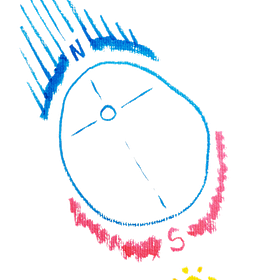“It is not words only that are emblematic; it is things which are emblematic. Every natural fact is a symbol of some spiritual fact. Every appearance in nature corresponds to some state of the mind, and that state of the mind can only be described by presenting that natural appearance as its picture.”1 - Ralph Waldo Emerson
Read Part 1 here. Read Part 2 here. Read Part 3 here.
When I think about warmth inside me and warmth outside me, I can only remain me if I am able to maintain a distinctly different climate within my organism. I cannot simply be the same temperature as the ambient world. I cannot live off such “mineral” warmth but rather must be able to cool certain aspects of my living body while simultaneously warming others — and all unconsciously. “You must not think that when we speak of the earliest warmth condition of the Earth we are speaking of such a warmth as arises when you strike a match. That is mineral-fire and mineral-warmth. We are speaking of the fire and warmth that pulsates in your blood; that is living warmth.”2 Warmth carried within an organism, flowing rhythmic pulse as in our dynamized blood, is not at all like the warmth outside us, which accumulates passively and radiates passively. As soon as I’ve warmed up enough, my body starts cooling to maintain homeostasis. If my habitual mood is gloomy or critical, then my inner warmth is stunted.
Steiner warns us: “Only experiences that [we have] during this feeling of warmth have real truth value; everything else is Lucifer’s work.”3 Unfelt knowledge is Luciferic. By contrast, I might add that ignorant feeling is Ahrimanic. If knowing something does not provoke love then it is not truly felt. I’d almost go so far as to say that the true experience of knowledge provokes tears. Dry eyes do not see as clearly as they imagine they do. The real experience of intimate knowing — as Adam “knew” his wife — is fundamentally unitive, essentially erotic. Living knowledge is love embued with enthusiasm. Dead knowledge is hard, callous, and sterile.
Living knowledge can never be dry, academic, or detached. We must feel what we know strongly enough in order to bring our ideals into action. Moreover, because loving someone or something is loving who they are not yet, it means that such knowledge is never finished, never settled, and always on the move. Love always presumes there is more that I don’t know than I do know. Even my foray here into the ideas of living warmth and “dead” warmth are done with a playful abandon — a delight in the world that is so awesome in its scope that we will never exhaust even one subject. But if you understand even one facet of the universe in a living way, it serves as a key to the rest of the universe. Steiner’s words are not the limit of knowledge — in fact, he denied that any such limit to knowledge existed! — but rather arrows pointing into the future. There is always ever more to know, and always more than I don’t know than I do. As such, the point isn’t about being right (though that’s also nice); the point is making magnanimous love contagious.
What we experience as “qualities” in the transient world are permanent things in eternity, not as abstractions but as the real deal. Qualities seem so ephemeral, but they are really expressions of eternal spiritual forces. This is part of the effectiveness of the biodynamic preparations: drawing from the living warmth already at work in plants, and bringing that into the earth. We are supplied with “dead warmth” from our climate and transmute it — to a degree appropriate to our organism — into living warmth. If we are not able to do so effectively, we may easily become overheated by external conditions — or, failing to bring warmth into our living organism — feel a sort of tepid malaise. Living warmth is not something the external world gave me — it is not the warmth of a hot day, but rather the warmth generated from within. “The important thing is the generation of heat in the manure, for the activity thus called into play is highly beneficial to the manure.”4 The inner living warmth produced out of one’s own being, that is living warmth. But this cannot be provoked from external circumstances. No one can force someone else to be enthusiastic, but enthusiasm tends to be contagious. Merely being around enthusiastic people has a particularly beneficial effect, especially for people lacking motivation.
Steiner says: “The warmth below the surface, especially during Winter, contains an inner vital principle.”5 There is warmth below the surface, real warmth. When we read “living warmth,” we might really read “enthusiasm” — in Winter, enthusiasm wakens within the earth. This happens on all levels. Even a warm stone placed in a cold environment “wishes” to rush outwards. There is no warmth anywhere that is truly dead.
Dead Warmth & Living Warmth (Part 1 of 5)
Have you ever been outside when it’s cold and then opened the door to a warm house? A torrent of warm, turbulent air rushes out, and another current of cold air moves inside. Our family perhaps yells at us to close the door as we stomp off the snow on our boots. When the door closes, the exchange of hot and cold becomes restricted.
A boulder or a dead log will warm up in the sun but has no ability to cool itself. It will simply get hot or cold based on the environment around us. In this sense, a stone is quite content being itself. It’s not trying to be anything else, either. When we look at a plant, though, a plant is trying to become something else — and that’s what makes it alive for us. But a plant can’t move, and if its soil dries out, its direct relationship with water and mineral salts is of little use — the plant perishes if it is deprived of what it needs. The same is true, of course, for animals. Animals also perish outside a narrow range of conditions, but an animal has an indirect relationship with water and minerals: it can move from one place to another if need be, in search of water, food, or a salt lick. Because of this inner mobility, we can say that an animal has internalized more of the cosmos than the plant. “Human life, and to a certain extent the life of animals as well has become emancipated to a large extent from world-workings outside them. The nearer we come to man, the more strongly marked is this emancipation.”6 This “emancipation” from the cosmos means a full internalization of the processes at work in the cosmos and being far less beholden to their influence. By contrast, animals do not have quite as much internalized and are therefore more influenced by their surroundings than we are.
Plants, though, are still relatively “naked” in relation to the cosmos: they require an astral environment to keep them warm and motivated. Without the energy flowing in from the Sun in spring and summer, plants do not feel the impetus to unfold their forms whereas a mammal is always striving to maintain its distinct inner warmth and climate. A plant “waits” for the right season and only then grows, while domesticated animals can reproduce almost any time of year. But if you get a late frost, blossoms in an orchard have little defense mechanism against such an event, while mammals can seek shelter, provide milk, and generate some of their own warmth when faced with cold.
Dead Warmth & Living Warmth (part 2 of 5)
“I change my mind a lot… I don’t usually agree with what I say very much.” - David Bowie
Everything in the phenomenal world is like an icon through which the spiritual world may be viewed. Or rather, appearances may be redeemed when viewed iconographically. The term maya does not specifically mean “illusion” though it has come to mean that. Maya is a cognate with the word magic: the manifesting powers of the invisible world. Appearances are only illusory when we imagine there are only surfaces. But we should know now that the vast majority of the electromagnetic spectrum is imperceptible to us. Even if we know everything about the sense-perceptible EMF spectrum, we would still only know a mere fraction of a percent of the universe. The vast majority of reality is invisible, yet nonetheless active. What we can sense is merely the tip of the iceberg. Nonetheless, each living thing is an “emblem” of the whole, a microcosm of the macrocosm. Each living thing doesn’t know how to lie about who it is: every visible animal (and plant) is a symbol of what it is.

While annual plants have the power to sustain themselves as well as grow and reproduce, they generally do not have much power to maintain their own bodily warmth the way warm-blooded animals do. One could say that mammals have internalized more of the unfolded cosmos to date than plants have.
As a pig is an extremely warm animal but cannot make use of their warmth for thinking, a plant is able to accumulate cosmic forces that are not of direct use to itself, namely in the nutritional aspects, particularly fruit. While evolutionary biologists may provide an “explanation” for why this has happened, namely, that attractive sweet fruits increased the probability of a particular species surviving, this does not reach to the heart of the matter: these plants are able to accumulate a surplus of forces that are not directly useful for themselves. If I cannot contain my own living warmth, it cannot rise to the difficult work of thinking — at best, without being able to contain my own living warmth, I can express erratic emotions. But an emotional “flash in the pan” is not at all like a contained fire in a wood stove.
In biodynamics, we seek to bring light and warmth into the living earth, and to regulate its expression, leading us all progressively to wholeness.
Emerson, Selected Essays, Nature
R. Steiner, The Influence of Spiritual Beings Upon Man, Lecture V (GA102, 16 March 1908, Berlin)
R. Steiner, Esoteric Lessons II, Lecture XIII (GA266, Berlin, 11-4-'10)
R. Steiner, Agriculture Course, Lecture V (GA327, 13 June 1924, Koberwitz)
R. Steiner, Agriculture Course, Lecture II (GA327, 10 June 1924, Koberwitz)
R. Steiner, Agriculture Course, Lecture I (GA327, 7 June 1924, Koberwitz)









